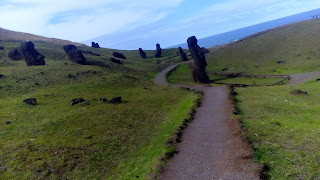Text, Videos and Photos: Ronian Carvalho
 |
| Semi-sculpted moai on the quarry of the Rano Raraku volcano |
About 20 km away from Hanga Roa village, Rano Raraku volcano is on the northeast coast of the Easter Island and has two major attractions. The main one is the quarry on its slope where the Rapa Nui sculpted the island's famous moai. The other one, not that famous, but not less interesting, is the crater of the inactive Rano Raraku itself, which doesn't remind at all the lava well that it was once.
Quarry on the slope of the Rano Raraku volcano: where the moai were sculpted
Shortly after going through the admission control, where a park ranger stamps the entry ticket into Rapa Nui National Park, visitors continue to climb Rano Raraku slope by a short trail, which forks ahead. The left path leads to the crater of the volcano and the path to the right goes towards the quarry, where the moai were carved with basalt chisels. This trail is split into several other smaller ones and goes among dozens of those stone beings, all unfinished. Some are standing, others are inclined or even lying down. Many have just the head on display. Mysteriously the works of sculpture and transportation of these moai seem to have been suddenly paralyzed and to be still waiting to be finished.
 |
| Trail among unfinished moai |
If the moai were carved on the steep slopes of this volcano, weighed at least 5 tons and most of them were more than 4 meters high, how the hell could the Rapa Nui carry all their more than 900 copies to several places of the Easter Island? Considered the greatest mystery of the most isolated inhabited island in the world, there are several theories for this. Unlikely versions claim that the moai came to life and walked by themselves or were transported with the help of extraterrestrials. A more serious theory says that the Rapa Nui tied ropes at the height of the moai's eyes and dragged them standing, swinging them periodically to their sides to keep them balanced. Another theory says that they were transported over wooden platforms, which would explain why there were almost no trees on the island, as the Rapa Nui would have cut them down to transfer the moai. This would also be the reason why the population of the island would have been radically reduced by the XVI century of the Christian era: the almost absence of trees would have led the island to an environmental collapse that would have provoked wars among the tribes because of the scarce natural resources. Truth or not, it's a great lesson for the humankind, right?
 |
| The beautiful Rano Raraku's crater |
Returning to the starting trail to follow the path leading to Rano Raraku's crater, the visitor may be a little disappointed if a visit to Rano Kau's has already been paid. After ascending a ladder carved on the slope of the volcano, one arrives to a slight and almost circular depression with a lake full of bushes in its center. Some twisted trees around complete the "too quiet" environment of the place. But for safety, it's forbidden to go down there or even to get near the lake.
In the crater of the Rano Raraku volcano
Another attraction that isn't on the volcano, but which is very close to it, is the Ahu Tongariki. From certain stretches of the trail through Rano Raraku quarry it's possible to have a great view of these fifteen moai lined side by side, along with the entire east coast of Easter Island. This is the largest moai's altar and, because of its large amount of stone beings, it's the one that most impresses the visitor. Many people aren't glad just to photograph it, but also try to touch it, which is prohibited and well supervised by the local park rangers. Others end up meditating or kneeling in front of these fifteen majestic beings.
 |
| Ahu Tongariki: moai's army showing up |
There are several ways to get to Rano Raraku. Loose-budget visitors can rent cars or motorbikes to tour the Easter Island or hire excursions that visit the main attractions of the island and cost about CLP$ 25,000. Whereas low-cost travelers can rent bikes and go cycling a lot, ask for a ride to the friendly Rapa Nui, who don't miss a chance to interact with visitors, or even walk exhaustively under the Polynesian sun enjoying the infinite blue of the Pacific on the east coast of the island. Everything is worth not to miss the incredible place of origin of the enigmatic moai.
 |
| East coast of the Easter Island seen from the quarry of the Rano Raraku volcano |


0 comentários:
Postar um comentário